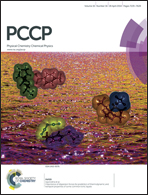Electrodeposited ZnO nanowires as photoelectrodes in solid-state organic dye-sensitized solar cells†
Abstract
A new approach for developing solid-state dye-sensitised solar cells (DSSCs) on glass/ITO and plastic substrates (PEN/ITO) is presented in this manuscript. A two step electrodeposition technique has been employed to realize the ZnO photoelectrodes. First a ZnO thin film is deposited on the ITO substrate and subsequently on this buffer layer 650 nm long ZnO nanowires are grown. The different nanostructured electrodes are crystallized and show a transparency close to 80% in the visible spectral range. The electrodes are then sensitized with a new purely organic dye, whose synthesis is presented here, which reveals a wide absorption spectrum and a high molar extinction coefficient. Finally, the sensitized electrodes were employed for the fabrication of liquid and solid-state DSSCs, using, respectively, a liquid iodine/iodide electrolyte and the spiro-OMeTAD hole transporter. These devices represent the first solid-state DSSCs fabricated using electrodeposited zinc oxide nanowires. Their power conversion efficiency is still limited, respectively, 0.18% and 0.03% under standard AM 1.5G sunlight (100 mW cm−2), nevertheless, these results prove the interest in this low-temperature deposition method for the realization of nanostructured electrodes on rigid and flexible substrates, and open up new perspectives for the development of solid state DSSCs on plastic substrates.


 Please wait while we load your content...
Please wait while we load your content...